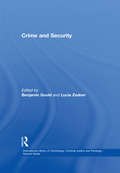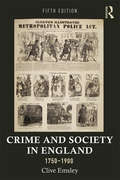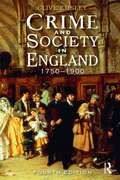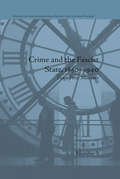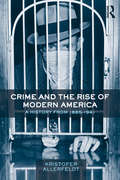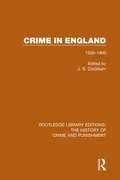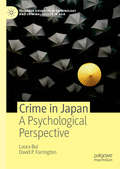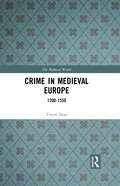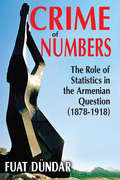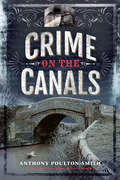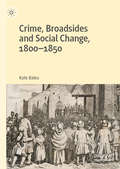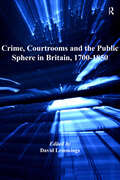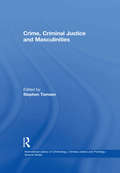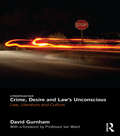- Table View
- List View
Crime and Punishment in Victorian London: A Street Level View of the City's Underworld
by Ross GilfillanDiscover the seamy history of nineteenth-century England that has inspired countless crime novels and films. Victorian London: All over the city, watches, purses, and handkerchiefs disappear from pockets; goods migrate from warehouses, off docks, and out of shop windows. Burglaries are rife, shoplifting is carried on in West End stores, and people fall victim to all kinds of ingenious swindles. Pornographers proliferate and an estimated eighty thousand prostitutes operate on the city&’s streets. Even worse, the vulnerable are robbed in dark alleys or garroted, a new kind of mugging in which the victim is half-strangled from behind while being stripped of his possessions. This history takes you to nineteenth-century London&’s grimy rookeries, home to thousands of the city&’s poorest and most desperate residents. Explore the crime-ridden slums, flash houses, and gin palaces from a unique street-level view—and meet the people who inhabited them.
Crime and Punishment in the Russian Revolution: Mob Justice and Police in Petrograd
by Tsuyoshi HasegawaRussians from all walks of life joyously celebrated the end of Nicholas II’s monarchy, but one year later, amid widespread civil strife and lawlessness, a fearful citizenry stayed out of sight. Tsuyoshi Hasegawa offers a new perspective on Russia’s revolutionary year through the lens of violent crime and its devastating effect on ordinary people.
Crime and Security (International Library Of Criminology, Criminal Justice And Penology - Second Ser.)
by Lucia Zedner Benjamin GooldThe pursuit of security is now central to the development of public policy and a driving force behind the spread of private policing. Just as new theoretical frameworks are needed to deal with the increasing tendency of crime control policies to focus on risk reduction, new forms of governance are also required to deal with the rapid growth of the private security industry. This volume brings together a wide range of contributions from leading scholars in the field and includes international and comparative perspectives on the challenges posed by the rise of the 'security society'.
Crime and Society in England, 1750–1900 (Themes In British Social History)
by Clive EmsleyRanging from the middle of the eighteenth through to the end of the nineteenth century, Crime and Society in England, 1750–1900 explores the developments in policing, the courts and the penal system as England became increasingly industrialised and urbanised. Through a consideration of the difficulty of defining crime, the book presents criminal behaviour as being intrinsically tied to historical context and uses this theory as the basis for its examination of crime within English society during this period. In this fifth edition Professor Emsley explores the most recent research, including the increased focus on ethnicity, gender and cultural representations of crime, allowing students to gain a broader view of modern English society. Divided thematically, the book’s coverage includes: the varying perceptions of crime across different social groups crime in the workplace the concepts of a ‘criminal class’ and ‘professional criminals’ the developments in the courts, the police and the prosecution of criminals. Thoroughly updated to address key questions surrounding crime and society in this period, and fully equipped with illustrations, tables and charts to further highlight important aspects, Crime and Society in England, 1750–1900 is the ideal introduction for students of modern crime.
Crime and Society in England: 1750 - 1900
by Clive EmsleyAcknowledged as one of the best introductions to the history of crime in the eighteenth and nineteenth centuries,Crime and Society in England 1750-1900 examines thedevelopments in policing, the courts, and the penal system as England became increasingly industrialised and urbanised. The book challenges the old but still influential idea that crime can be attributed to the behaviour of a criminal class and that changes in the criminal justice system were principally the work of far-sighted, humanitarian reformers. In this fourth edition of his now classic account, Professor Emsley draws on new research that has shifted the focus from class to gender, from property crime to violent crime and towards media constructions of offenders, while still maintaining a balance with influential early work in the area. Wide-ranging and accessible, the new edition examines: the value of criminal statistics the effect that contemporary ideas about class and gender had on perceptions of criminality changes in the patterns of crime developments in policing and the spread of summary punishment the increasing formality of the courts the growth of the prison as the principal form of punishment and debates about the decline in corporal and capital punishments Thoroughly updated throughout, the fourth edition also includes, for the first time, illuminating contemporary illustrations.
Crime and Society in Twentieth Century England
by Clive EmsleyCrime and Society in Twentieth-Century England traces the broad pattern of criminal offending over a hundred year period that experienced unprecedented levels of upheaval and change. This period included two world wars, the end of the British Empire, significant shifts in both gender relations and ethnic mix and a decline in the power of the economy. In this new textbook, Professor Clive Emsley provides an up-to-date assessment of changes in attitudes to crime as well as of the developments in policing, in the courts and in penal sanctions over the course of the century. He explores the impact of growing gender equality and ethnic diversity on crime and criminal justice, and looks at the way in which crime became increasingly central to political agendas in the last third of the century. Written in a clear and accessible manner, the book examines: Perceptions of crime and criminality across the century Varieties of offending from murder to benefit fraud The role of the media in constructing and reinforcing the understanding of crime and the criminal The decline and demise of corporal and capital punishment The shift from largely progressive to more punitive penal practice The first serious attempt to explore the history of crime and criminal justice in twentieth-century England, this book will be an invaluable introduction to the student and interested general reader alike.
Crime and the Construction of Forensic Objectivity from 1850: Space, Media, Experts And Ethics (Palgrave Histories of Policing, Punishment and Justice)
by Alison AdamThis book charts the historical development of 'forensic objectivity' through an analysis of the ways in which objective knowledge of crimes, crime scenes, crime materials and criminals is achieved. Taking an interdisciplinary approach, with authors drawn from law, history, sociology and science and technology studies, this work shows how forensic objectivity is constructed through detailed crime history case studies, mainly in relation to murder, set in Scotland, England, Germany, Sweden, USA and Ireland. Starting from the mid-nineteenth century and continuing to the present day, the book argues that a number of developments were crucial. These include: the beginning of crime photography, the use of diagrams and models specially constructed for the courtroom so jurors could be ‘virtual witnesses’, probabilistic models of certainty, the professionalization of medical and scientific expert witnesses and their networks, ways of measuring, recording and developing criminal records and the role of the media, particularly newspapers in reporting on crime, criminals and legal proceedings and their part in the shaping of public opinion on crime. This essential title demonstrates the ways in which forensic objectivity has become a central concept in relation to criminal justice over a period spanning 170 years.
Crime and the Fascist State, 1850–1940 (Studies for the International Society for Cultural History #5)
by Tiago Pires MarquesBy studying the development of Italy's penal system, Pires Marques provides valuable insights into the wider political culture of European society. Focusing on the rise of fascism in Spain and Portugal as well as Italy, he examines the role of religious, economic and political factors in the making of penal laws.
Crime and the Nation: Prison and Popular Fiction in Philadelphia. 1786-1800 (Studies in American Popular History and Culture)
by Peter OkunCrime and the Nation explores the correlation between fiction writing and national identity in the late eighteenth century when these two enterprises went hand in hand. The 1780s and '90s witnessed a spirited public debate on crime and punishment that produced a new kind of fiction and a new kind of prison. The world's first penitentiary-style prison opened at Philadelphia in 1790. At the same time jurists, reformers and fiction writers found new uses for the criminal. Suddenly, he was fascinating, he was edifying to the community, he was worth displaying and reforming. In a young nation whose very origins were perceived as criminal, yet clearly necessary and ultimately redeemable, crime emerged as an essential-and controversial-component of national identity. Crime and the Nation explores the nature of that identity, and the origins of America's unique and enduring love affair with crime and crime fiction.
Crime and the Rise of Modern America: A History from 1865–1941
by Kristofer AllerfeldtIn Crime and the Rise of Modern America, Kristofer Allerfeldt studies the crimes, criminals, and law enforcement that contributed to a uniquely American system of crime and punishment from the end of the Civil War to the eve of World War II to understand how the rapidly-changing technology of transportation, media, and incarceration affected the criminal underworld. In ten thematic chapters, Crime and the Rise of Modern America turns to the outlaws of the iconic West and the illegal distilleries of Prohibition, the turn-of-the-century immigrants, and the conmen who preyed on the people of the Promised Land, to examine how crime and America both changed, defining each other.
Crime in Early Modern England 1550-1750 (Themes In British Social History)
by James A SharpeStill the only general survey of the topic available, this widely-used exploration of the incidence, causes and control of crime in Early Modern England throws a vivid light on the times. It uses court archives to capture vividly the everyday lives of people who would otherwise have left little mark on the historical record. This new edition - fully updated throughout - incorporates new thinking on many issues including gender and crime; changes in punishment; and literary perspectives on crime.
Crime in England: 1550-1800
by J. S. CockburnThis volume, first published in 1977, brings together eleven studies of crime and the administration of the criminal law in England during the early modern period. They represent a variety of approaches – legal, historical and sociological – to the study of historical crime. The initial essay in this study, which is written from a legal standpoint, is the first coordinated account of the structure of criminal law administration in this formative period. It is followed by investigations into the nature and incidence of crime, court appearance and punishment, separate studies of witchcraft, infanticide and poaching, and an account of conditions in eighteenth-century Newgate. This book will be of particular interest to students of criminology and history.
Crime in Japan: A Psychological Perspective (Palgrave Advances in Criminology and Criminal Justice in Asia)
by David P. Farrington Laura BuiThis book reviews research on psychology and crime in Japan, and compares the findings with similar research conducted in Western industrialised countries. It examines explanations for crime and antisocial behaviour in Japan using research and theories from a psychological perspective. Topics covered include cultural explanations, developmental and life-course criminology, family violence and family risk factors, youth crime and early prevention, school factors and bullying, mental disorders, biosocial factors, psychopathy and sexual offending. In some parts, it challenges and refines the prevailing belief that Japan is a society characterised by low crime and little antisocial behaviour. This original project is the most up-to-date work on crime in Japan, and advances the important field of psychological criminology.
Crime in Japan: A Psychological Perspective (Palgrave Advances in Criminology and Criminal Justice in Asia)
by David P. Farrington Laura BuiThis book reviews research on psychology and crime in Japan, and compares the findings with similar research conducted in Western industrialised countries. It examines explanations for crime and antisocial behaviour in Japan using research and theories from a psychological perspective. Topics covered include cultural explanations, developmental and life-course criminology, family violence and family risk factors, youth crime and early prevention, school factors and bullying, mental disorders, biosocial factors, psychopathy and sexual offending. In some parts, it challenges and refines the prevailing belief that Japan is a society characterised by low crime and little antisocial behaviour. This original project is the most up-to-date work on crime in Japan, and advances the important field of psychological criminology.
Crime in Medieval Europe: 1200-1550 (The Medieval World)
by Trevor DeanWhat is the difference between a stabbing in a tavern in London and one in a hostelry in the South of France? What happens when a spinster living in Paris finds knight in her bedroom wanting to marry her? Why was there a crime wave following the Black Death? From Aberdeen to Cracow and from Stockholm to Sardinia, Trevor Dean ranges widely throughout medieval Europe in this exiting and innovative history of lawlessness and criminal justice. Drawing on the real-life stories of ordinary men and women who often found themselves at the sharp end of the law, he shows how it was often one rule for the rich and another for the poor in a tangled web of judicial corruption.
Crime in Medieval Europe: 1200-1550 (The Medieval World)
by Trevor DeanWhat is the difference between a stabbing in a tavern in London and one in a hostelry in the South of France? What happens when a spinster living in Paris finds knight in her bedroom wanting to marry her? Why was there a crime wave following the Black Death? From Aberdeen to Cracow and from Stockholm to Sardinia, Trevor Dean ranges widely throughout medieval Europe in this exiting and innovative history of lawlessness and criminal justice. Drawing on the real-life stories of ordinary men and women who often found themselves at the sharp end of the law, he shows how it was often one rule for the rich and another for the poor in a tangled web of judicial corruption.
Crime of Numbers: The Role of Statistics in the Armenian Question (1878-1918)
by Fuat DundarStatistics have played an important role in the recognition of the Armenian question on the international landscape as well as its "definitive solution" resulting in the Armenian genocide. The importance of statistics first surfaced at the Congress of Berlin in 1878, where differences in the approach toward numbers between the Armenian and the Ottoman Empire, and the role of statistics within the Ottoman state apparatus, became an issue. At that international gathering, the Armenian question was considered part of the "Eastern Question" paradigm of Western diplomacy. It would soon become a code word for the question of "civilization" itself.Those administering the multi-ethnic Ottoman Empire perceived the Armenian issue not only through ethnic and religious perspectives, but also through statistics. As Dundar shows, statistics became the vehicle through which the Ottoman state apparatus was forced to include non-Muslim populations of the Empire in the state apparatuses and local councils. This occurred long before the Armenian question surfaced. The aim of Ottoman reforms was to ensure that all communities participated in the affairs of the state and that such participation was proportionate to their numbers. Through its role in these reforms, statistics emerged as a constant matter of debate in the Armenian question.As a result of the Armenian genocide, the statistical record has become quite sensitive. Today, accounting for the numbers of Armenians murdered in 1915 usually means calculating the number of Armenians who were massacred or died of other causes such as disease, hunger, exhaustion, and the like during deportations or immediately after. This is a work of brilliant archival history and imaginatively uses social statistics.
Crime on the Canals
by Anthony Poulton-SmithA look at the history of crimes along Great Britain&’s canal network, from the author of The Origins of English Pub Names. Throughout our islands&’ history, we find tales of thieves, smugglers, thugs, and murderers. Books have been written retelling tales of bandits, footpads, highwaymen, et al, attacking the lone traveler, the horseman, the coachman, shipping line, locomotive engineer, lorry or van driver, and even pilot. Yet for almost two centuries, the majority of goods have travelled on Britain&’s famed canal network. This also attracted felons of all kinds, and yet these many tales had been ignored, until now. Within these pages, all manner of crimes are covered. From murders to muggings, parental problems to pilfering, arson, assault, smugglers, counterfeiters, and even road rage (albeit canal-style). But it is not all morbid and misery. Humor also plays a significant part in these tales. Why would a hungry man steal the inedible? Follow the policeman on foot chasing down a thief on board the narrowboat. Discover what really does lie beneath the waters of the canal. Learn canal etiquette, the hardships, the kindness, and the cruelty. From an author whose fascination with etymology has produced many books on origins of place names, leading to an interest in the historical modes of travel across our islands, this book is the latest to follow old routes and those found along them.
Crime on the Canals
by Anthony Poulton-SmithA look at the history of crimes along Great Britain&’s canal network, from the author of The Origins of English Pub Names. Throughout our islands&’ history, we find tales of thieves, smugglers, thugs, and murderers. Books have been written retelling tales of bandits, footpads, highwaymen, et al, attacking the lone traveler, the horseman, the coachman, shipping line, locomotive engineer, lorry or van driver, and even pilot. Yet for almost two centuries, the majority of goods have travelled on Britain&’s famed canal network. This also attracted felons of all kinds, and yet these many tales had been ignored, until now. Within these pages, all manner of crimes are covered. From murders to muggings, parental problems to pilfering, arson, assault, smugglers, counterfeiters, and even road rage (albeit canal-style). But it is not all morbid and misery. Humor also plays a significant part in these tales. Why would a hungry man steal the inedible? Follow the policeman on foot chasing down a thief on board the narrowboat. Discover what really does lie beneath the waters of the canal. Learn canal etiquette, the hardships, the kindness, and the cruelty. From an author whose fascination with etymology has produced many books on origins of place names, leading to an interest in the historical modes of travel across our islands, this book is the latest to follow old routes and those found along them.
Crime, Broadsides and Social Change, 1800-1850
by Kate BatesThis book explores the form, function and meaning of crime and execution broadsides printed in nineteenth-century Britain. By presenting a detailed discourse analysis of 650 broadsides printed across Britain between the years 1800-1850, this book provides a unique and alternative interpretation as to their narratives of crime. This criminological interpretation is based upon the social theories of Emile Durkheim, who recognised the higher utility of crime and punishment as being one of social integration and the preservation of moral boundaries. The central aim of this book is to show that broadsides relating to crime and punishment served as a form of moral communication for the masses and that they are examples of how the working class once attempted to bolster a sense of stability and community, during the transitional years of the early nineteenth century, by effectively representing both a consolidation and celebration of their core values and beliefs.
Crime, Courtrooms and the Public Sphere in Britain, 1700-1850
by David LemmingsModern criminal courts are characteristically the domain of lawyers, with trials conducted in an environment of formality and solemnity, where facts are found and legal rules are impartially applied to administer justice. Recent historical scholarship has shown that in England lawyers only began to appear in ordinary criminal trials during the eighteenth century, however, and earlier trials often took place in an atmosphere of noise and disorder, where the behaviour of the crowd - significant body language, meaningful looks, and audible comment - could influence decisively the decisions of jurors and judges. This collection of essays considers this transition from early scenes of popular participation to the much more orderly and professional legal proceedings typical of the nineteenth century, and links this with another important shift, the mushroom growth of popular news and comment about trials and punishments which occurred from the later seventeenth century. It hypothesizes that the popular participation which had been a feature of courtroom proceedings before the mid-eighteenth century was not stifled by ’lawyerization’, but rather partly relocated to the ’public sphere’ of the press, partly because of some changes connected with the work of the lawyers. Ranging from the early 1700s to the mid-nineteenth century, and taking account of criminal justice proceedings in Scotland, as well as England, the essays consider whether pamphlets, newspapers, ballads and crime fiction provided material for critical perceptions of criminal justice proceedings, or alternatively helped to convey the official ’majesty’ intended to legitimize the law. In so doing the volume opens up fascinating vistas upon the cultural history of Britain’s legal system over the ’long eighteenth century'.
Crime, Criminal Justice and Masculinities (International Library Of Criminology, Criminal Justice And Penology - Second Ser.)
by Stephen TomsenThis volume features the leading contemporary articles that are part of, or related to, the 'new masculinities' approach in this sphere. These comprise an impressive range of theoretical and empirical work including important cultural and ethnographic analyses. They emphasise the relationship between masculinities, the causes and patterns of most criminal offending and victimisation and the broader workings of the wider criminal justice system of policing (public and private), criminal courts, corrections and prisons. All of the material has been selected from flagship international journals and was produced by a global mix of male and female researchers with diverse disciplinary backgrounds. These scholars share the view that masculinities are plural, socially constructed, reproduced in the collective social practices of different men and embedded in institutional and occupational settings. Furthermore, masculinities are intricately linked with social struggles for power that occur between men and women and different men. Crime, criminal justice and their cultural representation are key terrain for these masculine contests and are always overlain with issues such as social class, age, race/ethnicity and sexuality.
Crime, Desire and Law's Unconscious: Law, Literature and Culture
by David GurnhamSexual desire, and the possible dangers associated with its more extreme manifestations, provokes strong, albeit often contradictory reactions. Such reactions are a well-known stimulant of creative, juridical and scholarly activity, and the texts of law, literature and academic criticism respond to it in ways that suggest both of revulsion and fascination. But how are we to understand such responses, and what can they tell us about the relationship between law and its‘others’? Exploring these questions in the context of HIV transmission, on-street sexual exploitation and erotic asphyxiation, this book draws on psychoanalytic theory in order to understand the motivations behind legal, literary and cultural constructions of sexual offences, their perpetrators and victims. Its analysis of these constructions in a diverse range of sources - including appeal judgments in England & Wales and North America, criminal trials and their reporting, visual and linguistic cultures and both modern and ‘classical’ literature – will be of great interest to legal theorists and socio-legal scholars, as well as those with relevant concerns in the fields of literature and cultural studies.
Crime, Enlightenment, and Punishment: Bureaucratic and Scientific Change in Habsburg Austria, 1750s–1820s
by Stephan Sander-FaesThis book studies the social consequences of bureaucratic and scientific change during the transition to modern states and societies in the Age of Enlightenment, as it explores how the Habsburg Empire deployed new ways and means to integrate existing structures into supra-regional systems of order.Exemplarily focused on Lower Austria, the book ties together the bustling imperial capital of Vienna and its hinterlands, where there was little economic, political, and social change before 1850. Previously unused archival materials such as administrative paperwork and printed wanted notes, in combination with published educational and legal texts, allow for the analysis of how bureaucratic procedures, social norms, and scientific change contributed to increasing exchange between Vienna, regional hubs such as Krems and Zwettl, and individual seigneurial holdings. Conceiving of these dynamics as a patchwork-in-progress, this study investigates state-making dynamics by transposing centralising norms and practices into everyday administration. It looks carefully at the intersections of local/central authority, offering a way beyond binary centre-periphery assumptions.This volume will be of interest to scholars of the history of state-making in and beyond Europe. Its up-to-date discussion of the pertinent historiography will also be useful for undergraduate and graduate students and teachers of comparative politics.
Crime, Gender and Consumer Culture in Nineteenth-Century England (The History of Retailing and Consumption)
by Tammy C. WhitlockWhilst the actual origins of English consumer culture are a source of much debate, it is clear that the nineteenth century witnessed a revolution in retailing and consumption. Mass production of goods, improved transport facilities and more sophisticated sales techniques brought consumerism to the masses on a scale previously unimaginable. Yet with this new consumerism came new problems and challenges. Focusing on retailing in nineteenth-century Britain, this book traces the expansion of commodity culture and a mass consumer orientated market, and explores the wider social and cultural implications this had for society. Using trial records, advertisements, newspaper reports, literature, and popular ballads, it analyses the rise, criticism, and entrenchment of consumerism by looking at retail changes around the period 1800-1880 and society's responses to them. By viewing this in the context of what had gone before Professor Whitlock emphasizes the key role women played in this evolution, and argues that the dazzling new world of consumption had beginnings that predate the later English, French and American department store cultures. It also challenges the view that women were helpless consumers manipulated by merchants' use of colour, light and display into excessive purchases, or even driven by their desires into acts of theft. With its interdisciplinary approach drawing on social and economic history, gender studies, cultural studies and the history of crime, this study asks fascinating questions regarding the nature of consumer culture and how society reacts to the challenges this creates.


